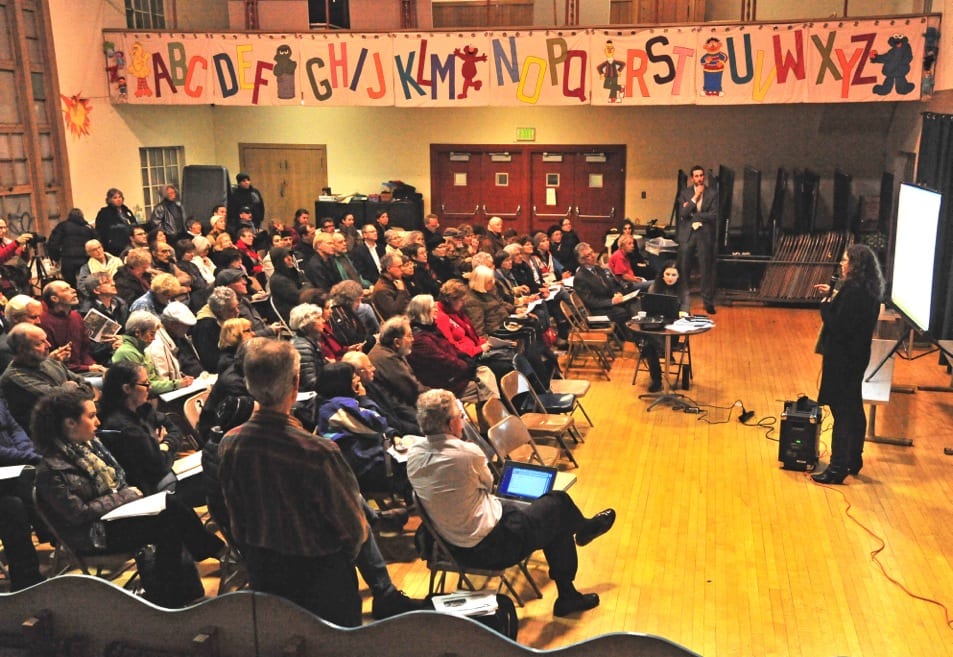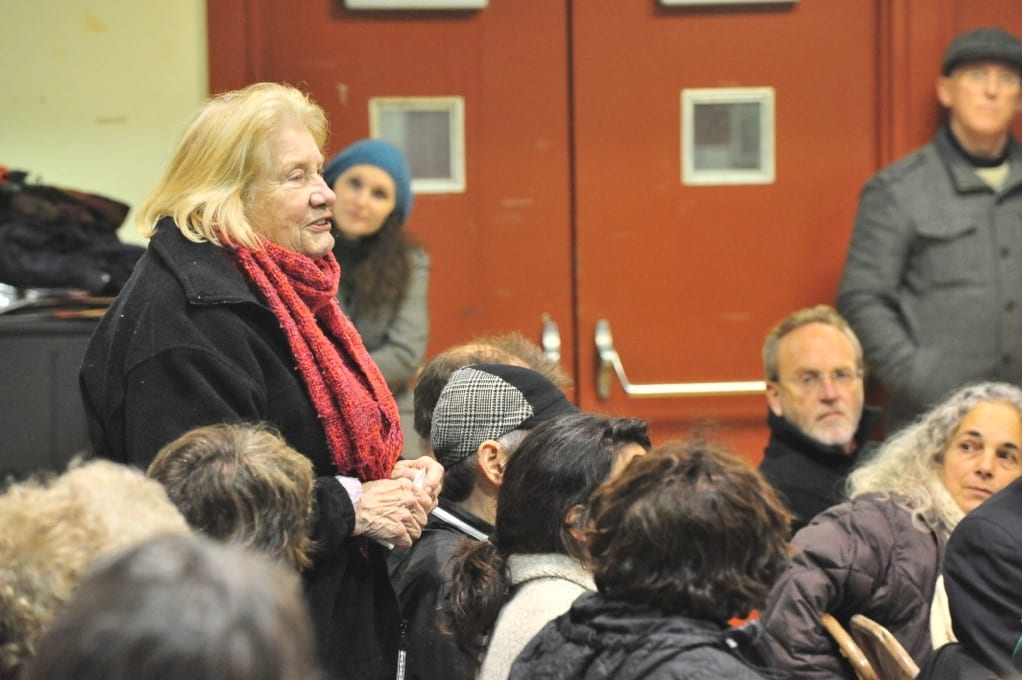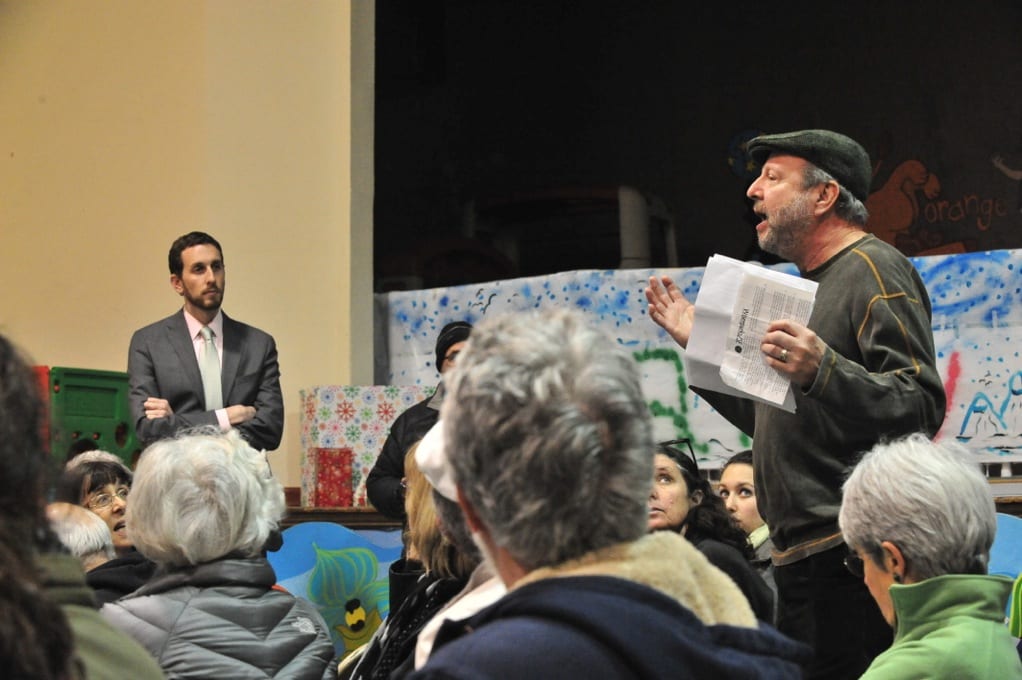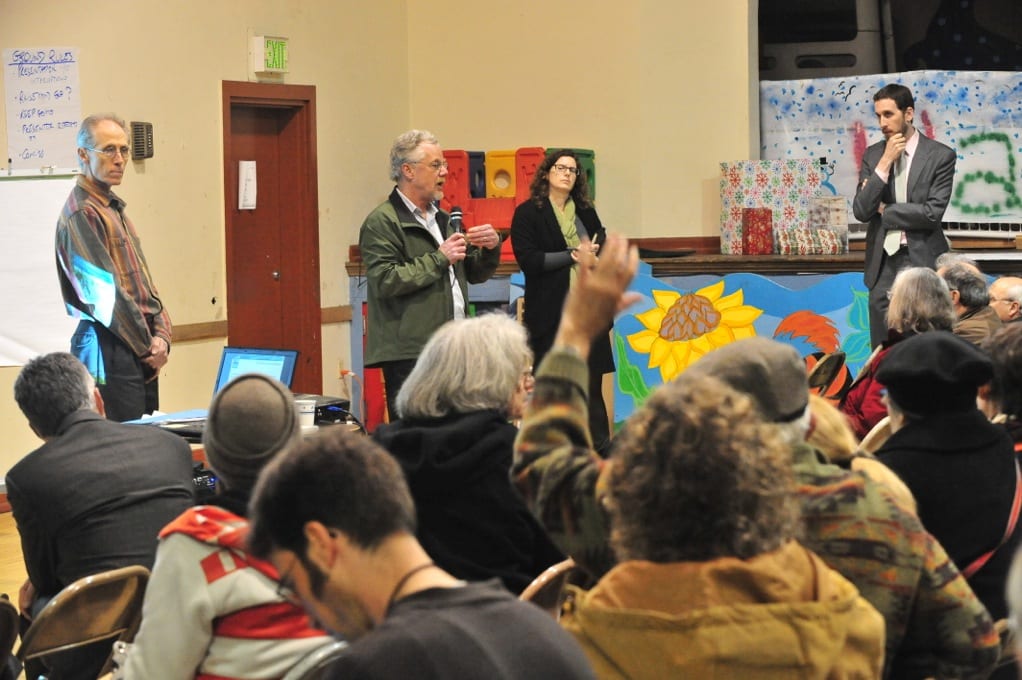
GLEN CANYON PARK RECREATION CENTER PROJECT UPDATE MEETING: Controversy Over Tree Removal Remains
By Bonnee Waldstein
Photos by Michael Waldstein
The old recreation center auditorium in Glen Canyon Park was standing room only on Jan. 7, 2013. Over 150 interested people gathered–rather, huddled–in what felt like subfreezing indoor temperatures. Those who came early enough for seating braved metal folding chairs that made one’s rear feel like a winter dip into San Francisco Bay.
One point that drew no opposition was that, as part of the 2008 Clean and Safe Neighborhoods bond fund, the recreation center will soon be getting a new heating system. (Is there even an old one?)
District 8 Supervisor Scott Wiener and Karen Mauney-Brodek of San Francisco Department of Recreation and Parks co-sponsored a community forum on January 7 to update Glen Park on the renovation project in the recreational areas of the park. The main focus was on the removal of eucalyptus and other trees to make way for the relocation of the tennis courts which, in turn, will allow a newly expanded children’s playground.
Choosing the projects to be undertaken, and figuring the details of fitting all the puzzle pieces together, were hammered out in a series of community meetings begun in late 2010.
From day one, the most contentious issue has been the plan to remove the trees. Work was set to start this past October and the contractor was at the ready when some last minute legal maneuvers aimed at saving the trees delayed groundbreaking until now.

Scott Wiener and Karen Mauney-Brodek held the meeting, not to revisit or revise the existing plan, but to clarify the reasoning for the tree removal and dispel any misconceptions about it. In fact, the felling of the trees began on January 10, three days after the meeting. The entire project will take 10 months.
Wiener noted at the outset “People agree on the need for changes to the park. We need to make sure that everyone has complete and accurate information. We’re all entitled to our own opinion but not our own facts. We as a city haven’t done a great job maintaining our urban forest. The Recreation and Parks Department doesn’t control its budget; it’s gone down over time for both street trees and park trees. We’re working to generate more funding but we don’t have resources to keep checking on failing trees.”
Many numbers have been bandied about. Wiener said that 58 trees are impacted by the project, six will be retained, and 163 trees and thousands of other shrubs will be planted.
In her presentation, Mauney-Brodek noted the broad factors in a healthy urban forest: healthy trees, not susceptible to disease and pests, of diverse species and age.

We now have a lot of older trees of one general size. We don’t know the exact number of trees in the park, but it’s believed to be in the 6,000 range. Most of them were planted 50 to 100 years ago, so they are the same age, with low diversity and therefore all reaching the end of life at the same time. Many haven’t received major physical attention. In a recent study it was determined that there is only enough funding to work on each tree in the park once every 50 years.
Arborist Jim Clark of HortScience was involved in evaluating the trees close to the project. The focus was on the areas of greatest potential danger where the most people gather. With standard techniques used all over the country, his team assessed the health, structure and likelihood of failure of the trees or parts of trees. Protocols were used for hazard ranking, 3 being low and 12 the highest. The threshold for action is a 9 rating. The same assessment techniques were used as in 18 other park properties that are part of the 2008 bond fund.
Some bottom line numbers:
- 627 trees in Glen Canyon Park were assessed.
- 147 of those are in the project area.
- 58 trees will be removed as part of the renovation.
- 52 of those have poor suitability for preservation. They are expected to decline in health regardless of measures to preserve them. Of them, 43 are in poor condition, 8 are in fair condition and one is standing dead.
- Six of them are being removed due to the renovation.
The remarks by Wiener and the presentation by Mauney-Brodek and some others were followed by a question and answer period, which was supposed to last thirty minutes but went well over an hour. Below is an attempt at a fairly comprehensive, though condensed, account.

Q: I’m concerned about trees not being cared for because there’s not enough staff. Volunteers plant trees that no one takes care of. What are you doing about hiring more city gardeners?
A: Dennis Kern, director of operations, RPD: We have an urban forestry division with tree crews, arborists and gardeners. Crews work with volunteers in reforestation during a 2-4 year establishment period.
Scott Wiener: We have a history of planting trees and no money to maintain them. Notices are going out about turning over street trees to property owners. A tree-funding stream is needed long term. Trees don’t compete well against health, safety needs in the city budget.
Q: Why not show in your diagrams the actual tree that will be planted vs. their eventual height?
A: It’s a given – trees take time to grow.
Q: Why can’t people work on the trees instead of cutting them down? Put the same resources to maintain the trees already there.
A: There are different funding sources. The funding used for renovation provides the money to establish the trees, not to maintain them. The trees being taken down are in poor condition. We need a healthier forest
Q: (to HortSscience arborist) What people in the city have you been involved with? How is it you have this contract?
A: There was a competitive bidding process. A Request for Proposal went out from the City. We submitted our response detailing experience and qualifications. It was a standardized process governed by the administrative code.
Comment from Zoe Nordstrom, neighborhood activist, one of the “Gumshoe Ladies” who fought expansion of a highway through Glen Park in the ‘70s: I think it will be great. This is a really constructive project so I hope it goes.
Q: Was any comparison done of the cost of renovation and the cost of carbon offsets and cutting the trees?
A: The Recreation and Parks plan is the most cost effective
Q: The term “poor suitability for preservation” actually refers to development projects, such as real estate subdivisions, not forestry in a park. This is a misleading term. All are suitable in a park unless hazardous. Only ONE is hazardous. Also, “non-native” has been developed as a factor for tree removal for this city only.
A: We don’t consider whether native or non-native. We consider whether it’s invasive. There are tremendous differences. Invasive describes not just trees but any plant that would reproduce and disturb natural ecosystems, outcompete other plant communities and inhibit their reproduction. We use information provided by the California Invasive Plant Council. In Glen Canyon it’s likely that there were only three native species when the Spanish arrived. Anything else is non-native. What is native? Is it the geographic region, Glen Park, the state, America?
Q: Your history is quite unfortunate. Reforestation is a myth as far as Rec and Park goes. Most trees will be 6-10 feet when planted.
A: Trees do take time to grow.
Q: (Miriam Moss of Friends of Glen Park) We had no input into the tennis courts. They are in the wrong orientation. With trees next to the courts the roots will grow under and crack the courts, water will get underneath and undermine them.
A: We selected certain types of species to mitigate this. They are not deciduous and don’t have the same root systems.
Q: Why are you “clear-cutting” trees which are only in the middle of the hazard scale and planting new ones instead of preserving them?
A: We have incorporated that into our thinking and built our plan around it. We want to give new trees the best possible chance over the establishment period. We can’t use bond money for maintenance. There are clear lines about the use of public funds. They are for capital and renovation projects only.
Q: Once you cut down the trees, what is Plan B if they die or don’t thrive?
A: Our operations and reforestation teams will replant. We have a massive volunteer program and corporate cleanup days. It’s a many-pronged approach.
Q: Glen Canyon Park has a California historical landmark, #1002, where there was a dynamite factory which blew up, of which nothing remains, obviously(!) There are prohibitions regarding alteration to the landscape. Has any consideration been given to historic preservation? Our community has forgotten about this piece of history. It was also envisioned to maintain a tree-lined promenade.
A: In the renovation of the Elk Street access there is a trail to allow for a continuous promenade. As to the historical marker, that’s an interesting point. We’ll have to look into that.
Q: Why are you moving the tennis courts in such a way that several mature eucalyptus trees will be removed, and not take into account the orientation towards the sun?
A: We evaluated several locations in our community meetings. Right now they’re not due east/west. Fully north/south would be the meadow above the recreation center. In the community process we looked at tradeoffs, such as creek runs. In the end, the location is not truly north/south but a slightly better orientation. The plan must provide compromise, consider the larger playground, the Elk Street drop-off, etc. The impact on the eucalyptus was discussed at the Rec and Park Commission and was considered in the project.
Q: Why are you taking down trees rated 5,6, and 7 even though they’re not reaching threshold for action?
A: Our forestry program has inspected the trees around the high use areas and determined there are potential safety issues.
Q: We’re ALL IN DECLINE!! What are you doing about the bats—they’re a protected species living in the eucalyptus trees?
A: Good question.
Q: The plan makes sense because we have the money to plant now. Fast forward two years, do you think people will volunteer to maintain the plants we care about?
A: The volunteer services section in Rec and Park welcomes stewardship, people to work with the reforestation crew and gardeners.
Q: I’ve done a lot of research regarding saving the eucalyptus trees in Sutro Forest. Having the same age trees can be a problem with certain types of trees but not eucalyptus. They can live 300-500 years. They encourage sprouts from underground root systems and the forest renews itself without having to be replanted. Out of the 163 trees to be replanted, only half are what we’d recognize as trees. 41 are shrubs, 38 are small trees of 20-30 feet, and 51 are medium 40-60 feet. In the plan submitted to the contractor, there are only 6 big cottonwood trees.
A: 300-500 years is a supposition based on our climate, rainfall, etc. The eucalyptus trees have been here for at most 150 years.
Scott Wiener observed that some are wrongly assuming that the trees will be here for the long run if nothing is done. “We’re looking at trees that are five years from decline. These trees have been assessed to be in decline even if they’re not hazardous now. We don’t have the resources to keep re-evaluating. That’s the situation.”
Check the project website at:
http://sfrecpark.org/project/glen-canyon-park-improvement-plan/
